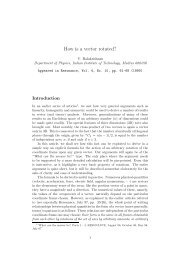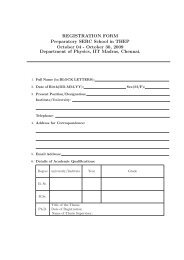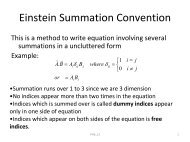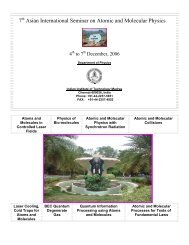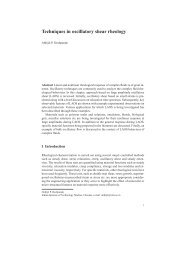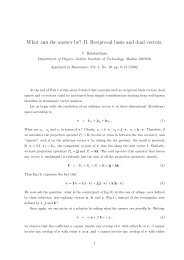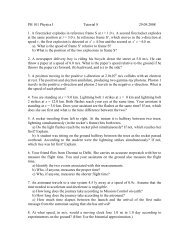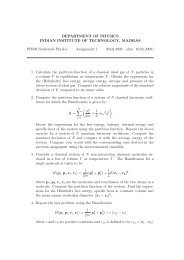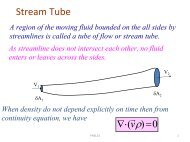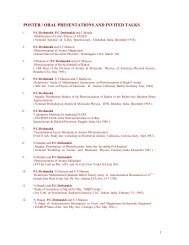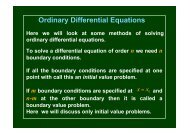Symmetry Principles and Conservation Laws in Atomic and ...
Symmetry Principles and Conservation Laws in Atomic and ...
Symmetry Principles and Conservation Laws in Atomic and ...
You also want an ePaper? Increase the reach of your titles
YUMPU automatically turns print PDFs into web optimized ePapers that Google loves.
GENERAL ARTICLEThe constancy of the LRL vector is a conservation pr<strong>in</strong>ciple,<strong>and</strong> s<strong>in</strong>ce the govern<strong>in</strong>g criterion <strong>in</strong>volves dynamics(namely that the force must have a strict <strong>in</strong>versesquare form), the associated symmetry is called `dynamicalsymmetry'. Sometimes, it is also called an `accidental'symmetry. This symmetry breaks down when thereis even a m<strong>in</strong>or departure from the <strong>in</strong>verse square lawforce, as would happen <strong>in</strong> a many-electron atom, suchas the hydrogen-like sodium atom. The potential experiencedby the `outer-most' electron goes as 1=r only <strong>in</strong>the asymptotic (r ! 1) region. Close to the center,the potential goes rather as ¡Z=r, due to the reducedscreen<strong>in</strong>g of the nuclear charge by the orbital electrons,<strong>and</strong> thus departs from 1=r. This di®erence <strong>in</strong> the hydrogenatom potential <strong>and</strong> that <strong>in</strong> the sodium atom is dueto the quantum analogue of the breakdown of the LRLvector constancy <strong>in</strong> the sodium atom. Us<strong>in</strong>g group theoreticalmethods, Vladmir Fock (1898{1974) expla<strong>in</strong>edthe dynamical symmetry of the hydrogen atom [5].Us<strong>in</strong>g the language of group theory, the Fock symmetryaccounts for the (2l + 1)-fold degeneracy of the hydrogenatom eigenstates. This degeneracy is lifted for thehydrogen-like sodium atom due to the breakdown of theassociated symmetry. In atomic physics, this is oftenexpressed <strong>in</strong> terms of what is called as `quantum defect'¹ n;l which makes the hydrogenic energy eigenvalues dependnot merely on the pr<strong>in</strong>cipal quantum number n butalso on the orbital angular momentum quantum numberl. This enables the use of the hydrogenic formulafor energy with n replaced by n e®ective = n ¡ ¹ n;l . The`quantum-defect theory' has very many applications <strong>in</strong>the analysis of the atomic spectrum, <strong>in</strong>clud<strong>in</strong>g the `autoionizationresonances' [6,7]. As po<strong>in</strong>ted out above,the conservation of angular momentum is due to the rotationalsymmetry, referred to as the symmetry underthe group SO(3). All central ¯elds have this symmetry.However, the <strong>in</strong>verse-square-law force (such as gravity orRESONANCE September 2010841



